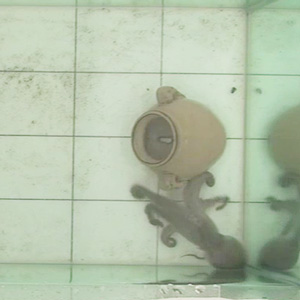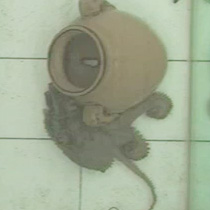
The octopus is a fascinating creature and probably the smartest invertebrate known. It has an extremely well developed visual system with high acuity, and although it cannot distinguish color, it can see polarized light. Scientists have proposed that octopuses communicate with each other by polarizing the light that reflects from their scales, creating a messaging system that could not be observed, much less understood by other creatures in their realm who have much less sophisticated visual systems (1).
Many animals rely on visual stimuli for recognizing predators, food and other members of their species. And scientists have used pictures, models and videos to attempt to understand how visual cues affect animal behavior. Pictures and models lack the movement aspect of live stimuli, so video playback presents the best, controllable method, for presenting visual stimuli. However, video has been designed for the human visual system, not that of the octopus, and until recently no video study has managed to elicit a biologically appropriate response from cephalopods (octopus, cuttlefish or squid).
Finally we may be catching up to the octopus. Researchers at Macquarie University in Australia and The University of Windsor in Canada, realized that recent advances in HD technology might give scientists a technology sharp enough to fool the keen-sighted gloomy octopus (Octopus tetricus; 2). Their recent study had two objectives. First, the authors wanted to see if they could design a video playback system that could generate biologically appropriate responses from gloomy octopuses, and second, they wanted to see whether individual animals would respond consistently over time to these video stimuli.

The authors filmed four types of video stimulus: control, food, conspecific and novel in an attempt to elicit typical behaviors from the octopuses. Video of a crab was used to represent typical food to stimulate foraging behavior. Video of another octopus was used to simulate a threatening, aggressive encounter, and video of a jar (novel object) was used to investigate boldness and exploratory behavior. The control was a video of the empty aquarium in which the other objects had been filmed. Three different video clips were made of each of these types of stimuli. The three-minute videos were shown to the octopuses randomly.
Videos were filmed using an HD camera and played on a screen with a refresh rate that matched the frame rate of the camera. Additionally the refresh rate of the LCD screen approached the limit of flicker detectable by the octopus visual system.
Each octopus was tested on three separate days, the day after capture, four days later, and four days after that. Testing was timed to coincide with the normal twilight/nighttime activity of the gloomy octopus. The team measured responses including movement, latency (time taken for the octopus’ eye to cross the first gridline of the Cartesian coordinate aquarium floor after the stimulus was shown), brightness change of the octopus’ body, chromatic/texture pattern change of the octopus, and stimulus touches.
This is the first study to demonstrate biologically appropriate responses of a cephalopod to video stimuli. As a group, the 31 animals reacted differently to the three different stimuli. Generally they rapidly approached the crab stimulus, often using jet propulsion, and touched it, behaviors typical of those described for crab attacks observed in nature. When presented with the stimulus of another gloomy octopus, most animals reduced activity and hid behind or inside the terracotta pot provided for refuge. You can see videos of the octopuses responding to stimuli here: http://jeb.biologists.org/cgi/content/full/213/7/1035/DC1
As far as the question of gloomy octopus personality, individual animals behaved consistently throughout a given test period (several hours). An individual that was aggressive toward the crab, tended to be more aggressive when presented with the stimulus of another octopus and the novel object. However, on different test days, individual animals did not maintain that same “personality.” One that was characterized as “aggressive” on one test day might be characterized as “shy” on the next. The authors report that none of the personality traits were repeatable over time and suggest that the gloomy octopus has “episodic “ personality.
I don’t know what this new technology will ultimately reveal about these remarkably intelligent invertebrates, but I can’t wait until the movie comes out on Blu-Ray.
References
- Mäthger, L.M., Shashar, N. and Hanlon, R.T. (2009) Do cephalopods communicate using polarized light reflections from their skin? J. Exp. Biol. 212, 2133–40.
 Pronk, R., Wilson, D., & Harcourt, R. (2010). Video playback demonstrates episodic personality in the gloomy octopus Journal of Experimental Biology, 213 (7), 1035-1041 DOI: 10.1242/jeb.040675
Pronk, R., Wilson, D., & Harcourt, R. (2010). Video playback demonstrates episodic personality in the gloomy octopus Journal of Experimental Biology, 213 (7), 1035-1041 DOI: 10.1242/jeb.040675
Michele Arduengo
Latest posts by Michele Arduengo (see all)
- An Unexpected Role for RNA Methylation in Mitosis Leads to New Understanding of Neurodevelopmental Disorders - March 27, 2025
- Unlocking the Secrets of ADP-Ribosylation with Arg-C Ultra Protease, a Key Enzyme for Studying Ester-Linked Protein Modifications - November 13, 2024
- Exploring the Respiratory Virus Landscape: Pre-Pandemic Data and Pandemic Preparedness - October 29, 2024
